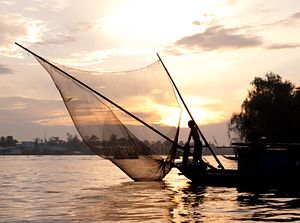Just after climbing the muddy, five-meter-high banks of the Mekong river near Yuen Sean, a reclusive village in northern Cambodia, a plain, wooden hut appears, its shape and size similar to the dozens of modest homes of the poor fishing families who live here.
Inside awaits a place of worship. Covered by curtains, whose orange has faded from the beams of sunlight shining through the planks, a glass casket lies in the middle of the hut. It’s the final resting place of a rare Irrawaddy freshwater dolphin, its spine, vertebrae and bulky skull assembled as if it were an ancient fossil.
The Irrawaddy dolphin is so rare and sensational to Cambodians that they believe the bumpy-headed gray mammal used to be human. Hundreds of years ago, the folk tale goes, a young girl who was pursued by an evil force sought help from the mighty Mekong. In answering her prayers, the Mekong turned the girl into a dainty river creature, able to escape her pursuers in the stream. This was the birth of the dolphin, villagers like Morn Da believe.
“Folk tales tell us that the dolphins originated from human beings, so that’s part of the reason why we love and care for the dolphins like human beings,” said the 27-year-old fisherman, who lives next to the shrine in Yeun Sean village.
“Their head looks like our heads, and they feed their babies the way we do. That’s why we love and care for the dolphins like they were human beings,” Da said.
The dolphin body that swept up on the shores of Yeun Sean village several years ago wasn’t disposed of, but carefully taken out of the dense, flooded forest, washed and placed into this handmade casket amid Buddha statues, golden cones and spires.
Da said that he’s used to seeing the mammals from when he was a child, but that their numbers have dwindled. Over a 100-mile stretch between the southern tip of Laos and northern Cambodia, 85 remaining dolphins have formed six habitats, or dolphin pools, that will remain their home until they perish.

































